Human Skin-Like Composite Materials for Blast Induced Injury Mitigation
Abstract
1. Introduction
2. Materials and Methods
2.1. Fabrication and Testing of Skin Simulant Material
2.2. Linear and Non-Linear Material Models Used in Computational Study
2.3. Geometrical Model
2.4. Finite Element Modeling
3. Results and Discussion
3.1. Blast Stresses in Unprotected Bone, Muscle and Skin Section Model
3.2. Blast-Induced Bone Stresses with Protective Composite Covering Variants
3.3. Blast-Induced Muscle Stresses with Composite Covering Variants
3.4. Effect of Fiber Volume Fraction on Blast Absorption in 0-0 Continuous Composite Covering
4. Conclusions
Author Contributions
Funding
Acknowledgments
Conflicts of Interest
References
- Schneiderman, A.I.; Braver, E.R.; Kang, H.K. Understanding sequelae of injury mechanisms and mild traumatic brain injury incurred during the conflicts in iraq and afghanistan: Persistent postconcussive symptoms and posttraumatic stress disorder. Am. J. Epidemiol. 2008, 167, 1446–1452. [Google Scholar] [CrossRef] [PubMed]
- Kulkarni, S.; Gao, X.-L.; Horner, S.; Zheng, J.; David, N. Ballistic helmets–their design, materials, and performance against traumatic brain injury. Compos. Struct. 2013, 101, 313–331. [Google Scholar] [CrossRef]
- Carey, M.E.; Herz, M.; Corner, B.; McEntire, J.; Malabarba, D.; Paquette, S.; Sampson, J.B. Ballistic helmets and aspects of their design. Neurosurgery 2000, 47, 678–689. [Google Scholar] [PubMed]
- Khalil, T.B.; Goldsmith, W.; Sackman, J. Impact on a model head-helmet system. Int. J. Mech. Sci. 1974, 16, 609–625. [Google Scholar] [CrossRef]
- Van Hoof, J. Modelling of Impact Induced Delamination in Composite Materials; Carleton University: Ottawa, ON, Canada, 1999. [Google Scholar]
- Van Hoof, J.; Worswick, M. Combining Head Models with Composite Models to Simulate Ballistic Impacts; Waterloo Univ (Ontario) Dept of Mechanical Engineering: Waterloo, ON, Canada, 2001. [Google Scholar]
- Daniel, B.; Rémy, W. Finite element modelling of human head injuries caused by ballistic projectiles. Revue Européenne des Eléments 2005, 14, 559–576. [Google Scholar] [CrossRef]
- Aare, M.; Kleiven, S. Evaluation of head response to ballistic helmet impacts using the finite element method. Int. J. Impact Eng. 2007, 34, 596–608. [Google Scholar] [CrossRef]
- Lee, H.-P.; Gong, S. Finite element analysis for the evaluation of protective functions of helmets against ballistic impact. Comput. Methods Biomech. Biomed. Eng. 2010, 13, 537–550. [Google Scholar] [CrossRef] [PubMed]
- Tan, L.B.; Tse, K.M.; Lee, H.P.; Tan, V.B.C.; Lim, S.P. Performance of an advanced combat helmet with different interior cushioning systems in ballistic impact: Experiments and finite element simulations. Int. J. Impact Eng. 2012, 50, 99–112. [Google Scholar] [CrossRef]
- Li, Y.; Li, X.; Gao, X.-L. Modeling of advanced combat helmet under ballistic impact. J. Appl. Mech. 2015, 82, 111004. [Google Scholar] [CrossRef]
- Rodríguez-Millán, M.; Ito, T.; Loya, J.; Olmedo, A.; Miguélez, M. Development of numerical model for ballistic resistance evaluation of combat helmet and experimental validation. Mater. Des. 2016, 110, 391–403. [Google Scholar] [CrossRef]
- Sarvghad-Moghaddam, H.; Karami, G.; Ziejewski, M. The effects of directionality of blunt impacts on mechanical response of the brain. In Proceedings of the ASME 2014 International Mechanical Engineering Congress and Exposition, Montreal, QC, Canada, 14–20 November 2014; p. V003T003A013. [Google Scholar]
- Ganpule, S.; Gu, L.; Alai, A.; Chandra, N. Role of helmet in the mechanics of shock wave propagation under blast loading conditions. Comput. Methods Biomech. Biomed. Eng. 2012, 15, 1233–1244. [Google Scholar] [CrossRef] [PubMed]
- Moss, W.C.; King, M.J.; Blackman, E.G. Skull flexure from blast waves: A mechanism for brain injury with implications for helmet design. Phys. Rev. Lett. 2009, 103, 108702. [Google Scholar] [CrossRef] [PubMed]
- Zhang, T.G.; Satapathy, S.S.; Dagro, A.M.; McKee, P.J. Numerical study of head/helmet interaction due to blast loading. In Proceedings of the ASME 2013 International Mechanical Engineering Congress and Exposition, San Diego, CA, USA, 15–21 November 2013; p. V03AT03A004. [Google Scholar]
- Nyein, M.K.; Jason, A.M.; Yu, L.; Pita, C.M.; Joannopoulos, J.D.; Moore, D.F.; Radovitzky, R.A. In silico investigation of intracranial blast mitigation with relevance to military traumatic brain injury. Proc. Natl. Acad. Sci. USA 2010. [Google Scholar] [CrossRef] [PubMed]
- Sarvghad-Moghaddam, H.; Rezaei, A.; Ziejewski, M.; Karami, G. Evaluation of brain tissue responses because of the underwash overpressure of helmet and faceshield under blast loading. Int. J. Numer. Methods Biomed. Eng. 2017, 33, e02782. [Google Scholar] [CrossRef] [PubMed]
- Sarvghad-Moghaddam, H.; Jazi, M.S.; Rezaei, A.; Karami, G.; Ziejewski, M. Examination of the protective roles of helmet/faceshield and directionality for human head under blast waves. Comput. Methods Biomech. Biomed. Eng. 2015, 18, 1846–1855. [Google Scholar] [CrossRef] [PubMed]
- Sarvghad-Moghaddam, H.; Rezaei, A.; Ziejewski, M.; Karami, G. Correlative analysis of head kinematics and brain’s tissue response: A computational approach toward understanding the mechanisms of blast tbi. Shock Waves 2017, 27, 919–927. [Google Scholar] [CrossRef]
- Chanda, A.; Unnikrishnan, V. Effect of bladder and rectal loads on the vaginal canal and levator ani in varying pelvic floor conditions. Mech. Adv. Mater. Struct. 2017. [Google Scholar] [CrossRef]
- Rodríguez-Millán, M.; Tan, L.; Tse, K.; Lee, H.; Miguelez, M. Effect of full helmet systems on human head responses under blast loading. Mater. Des. 2017, 117, 58–71. [Google Scholar] [CrossRef]
- Grujicic, M.; Bell, W.; Pandurangan, B.; He, T. Blast-wave impact-mitigation capability of polyurea when used as helmet suspension-pad material. Mater. Des. 2010, 31, 4050–4065. [Google Scholar] [CrossRef]
- Grujicic, M.; Pandurangan, B.; Bell, W.; Bagheri, S. Shock-wave attenuation and energy-dissipation potential of granular materials. J. Mater. Eng. Perform. 2012, 21, 167–179. [Google Scholar] [CrossRef]
- Jenson, D.; Unnikrishnan, V. Multiscale simulation of ballistic composites for blast induced traumatic brain injury mitigation. In Proceedings of the ASME 2014 International Mechanical Engineering Congress and Exposition, Montreal, QC, Canada, 14–20 November 2014; p. V009T012A072. [Google Scholar]
- Jenson, D.; Unnikrishnan, V.U. Energy dissipation of nanocomposite based helmets for blast-induced traumatic brain injury mitigation. Compos. Struct. 2015, 121, 211–216. [Google Scholar] [CrossRef]
- Chanda, A.; Callaway, C. Computational modeling of blast induced whole-body injury: A review. J. Med. Eng. Technol. 2018, 42, 88–104. [Google Scholar] [CrossRef] [PubMed]
- Chanda, A.; Unnikrishnan, V. Subject-specific computational study of blast induced traumatic injuries. In Proceedings of the Society of Engineering Science 52nd Annual Technical Meeting, College Station, TX, USA, 26–28 October 2015. [Google Scholar]
- Chanda, A.; Callaway, C.; Clifton, C.; Unnikrishnan, V. Biofidelic Human Brain Tissue Surrogates; Taylor & Francis: Oxfordshire, UK, 2016. [Google Scholar]
- Chanda, A.; Unnikrishnan, V. Human tissue simulants for study of traumatic brain injury (tbi). In Proceedings of the American Society for Composites: Thirty-First Technical Conference, Williamsburg, VA, USA, 19–22 September 2016. [Google Scholar]
- Chanda, A.; Unnikrishnan, V. A realistic 3d computational model of the closure of skin wound with interrupted sutures. J. Mech. Med. Biol. 2017, 17, 1750025. [Google Scholar] [CrossRef]
- Chanda, A.; Curry, K. Patient-specific biofidelic human coronary artery surrogates. J. Mech. Med. Biol. 2018, 18. [Google Scholar] [CrossRef]
- Gray, H.; Goss, C.M.; Alvarado, D.M. Anatomy of the Human Body; Lea & Febiger: Philadelphia, PA, USA, 1973. [Google Scholar]
- Chanda, A.; Graeter, R.; Unnikrishnan, V. Effect of blasts on subject-specific computational models of skin and bone sections at various locations on the human body. AIMS Mater. Sci. 2015, 2, 425–447. [Google Scholar] [CrossRef]
- Annaidh, A.N.; Bruyère, K.; Destrade, M.; Gilchrist, M.D.; Otténio, M. Characterization of the anisotropic mechanical properties of excised human skin. J. Mech. Behav. Biomed. Mater. 2012, 5, 139–148. [Google Scholar] [CrossRef] [PubMed]
- Chanda, A.; Unnikrishnan, V. Customized Insoles for Diabetic and Pressure Ulcers. U.S. Patent 15/646,046, 11 January 2018. [Google Scholar]
- Shergold, O.A.; Fleck, N.A.; Radford, D. The uniaxial stress versus strain response of pig skin and silicone rubber at low and high strain rates. Int. J. Impact Eng. 2006, 32, 1384–1402. [Google Scholar] [CrossRef]
- Martins, P.; Natal Jorge, R.; Ferreira, A. A comparative study of several material models for prediction of hyperelastic properties: Application to silicone-rubber and soft tissues. Strain 2006, 42, 135–147. [Google Scholar] [CrossRef]
- Chanda, A.; Unnikrishnan, V.; Roy, S.; Richter, H.E. Computational modeling of the female pelvic support structures and organs to understand the mechanism of pelvic organ prolapse: A review. Appl. Mech. Rev. 2015, 67, 040801. [Google Scholar] [CrossRef]
- Chanda, A.; Meyer, I.; Richter, H.E.; Lockhart, M.E.; Moraes, F.R.; Unnikrishnan, V. Vaginal changes due to varying degrees of rectocele prolapse: A computational study. J. Biomech. Eng. 2017, 139, 101001. [Google Scholar] [CrossRef] [PubMed]
- Chanda, A.; Unnikrishnan, V.; Richter, H.E.; Lockhart, M.E. Computational modeling of anterior and posterior pelvic organ prolapse (pop). In Proceedings of the ASME 2016 International Mechanical Engineering Congress and Exposition, Phoenix, AZ, USA, 11–17 November 2016; p. V009T012A085. [Google Scholar]
- Gonzalez, L.Y.S.; Botero, M.G.; Betancur, M. Hyperelastic Material Modeling; Technical Report; Departamento de Ingenieria Mecanica, Universidad EAFIT: Medellın, Colombia, 2005. [Google Scholar]
- Holzapfel, G.A. Nonlinear Solid Mechanics; Wiley: Chichester, UK, 2000; Volume 24. [Google Scholar]
- Chanda, A.; Unnikrishnan, V.; Richter, H.E.; Lockhart, M.E. A biofidelic computational model of the female pelvic system to understand effect of bladder fill and progressive vaginal tissue stiffening due to prolapse on anterior vaginal wall. Int. J. Numer. Methods Biomed. Eng. 2016, 32, e02767. [Google Scholar] [CrossRef] [PubMed]
- Chanda, A.; Flynn, Z.; Unnikrishnan, V. Biomechanical characterization of normal and prolapsed vaginal tissue surrogates. J. Mech. Med. Biol. 2018, 18, 1750100. [Google Scholar] [CrossRef]
- Chanda, A.; Callaway, C. Tissue anisotropy modeling using soft composite materials. Appl. Bionics Biomech. 2018, 2018, 4838157. [Google Scholar] [CrossRef] [PubMed]
- Chanda, A.; Unnikrishnan, V.; Lackey, K. Biofidelic conductive synthetic skin composites. In Proceedings of the American Society for Composites—Thirty-Second Technical Conference, West Lafayette, IN, USA, 23–25 October 2017. [Google Scholar]
- Chanda, A. Biofidelic Soft Composites–Experimental and Computational Modeling; University of Alabama Libraries: Tuscaloosa, AL, USA, 2017. [Google Scholar]
- Lim, J.; Chen, W.W.; Zheng, J.Q. Dynamic small strain measurements of kevlar® 129 single fibers with a miniaturized tension kolsky bar. Polymer Test. 2010, 29, 701–705. [Google Scholar] [CrossRef]
- Zhu, D.; Mobasher, B.; Rajan, S.D. Dynamic tensile testing of kevlar 49 fabrics. J. Mater. Civ. Eng. 2010, 23, 230–239. [Google Scholar] [CrossRef]
- Bertucci, R.; Liao, J.; Williams, L. Development of a lower extremity model for finite element analysis at blast condition. In Proceedings of the ASME 2011 Summer Bioengineering Conference, Farmington, PA, USA, 22–25 June 2011; pp. 1035–1036. [Google Scholar]
- Flynn, C.O. The Design and Validation of a Multi-Layer Model of Human Skin; Institute of Technology: Sligo, Ireland, 2007. [Google Scholar]
- Chanda, A.; Ruchti, T.; Unnikrishnan, V. Computational modeling of wound suture: A review. IEEE Rev. Biomed. Eng. 2018. [Google Scholar] [CrossRef] [PubMed]
- Chanda, A.; Unnikrishnan, V.; Flynn, Z.; Lackey, K. Experimental study on tissue phantoms to understand the effect of injury and suturing on human skin mechanical properties. Proc. Inst. Mech. Eng. Part H J. Eng. Med. 2017, 231, 80–91. [Google Scholar] [CrossRef] [PubMed]
- Chanda, A.; Unnikrishnan, V.; Flynn, Z. Biofidelic Human Skin Simulant. U.S. Patent 15/204353, 7 July 2015. [Google Scholar]
- Chanda, A.; Flynn, Z.; Unnikrishnan, V. Biofidelic Vaginal Tissue Surrogate. US Provisional Patent No. 62/263942, 7 July 2015. [Google Scholar]
- Jones, R.M. Mechanics of Composite Materials; McGraw-Hill: New York, NY, USA, 1975; Volume 1. [Google Scholar]
- McGrath, J.; Uitto, J. Anatomy and organization of human skin. In Rook’s Textbook of Dermatology, 8th ed.; Blackwell Science Ltd: Oxford, UK, 2010; pp. 1–53. [Google Scholar]
- Abe, T.; DeHoyos, D.V.; Pollock, M.L.; Garzarella, L. Time course for strength and muscle thickness changes following upper and lower body resistance training in men and women. Eur. J. Appl. Physiol. 2000, 81, 174–180. [Google Scholar] [CrossRef] [PubMed]
- De Boer, M.D.; Seynnes, O.R.; Di Prampero, P.E.; Pišot, R.; Mekjavić, I.B.; Biolo, G.; Narici, M.V. Effect of 5 weeks horizontal bed rest on human muscle thickness and architecture of weight bearing and non-weight bearing muscles. Eur. J. Appl. Physiol. 2008, 104, 401–407. [Google Scholar] [CrossRef] [PubMed]
- Durnin, J.; Rahaman, M. The assessment of the amount of fat in the human body from measurements of skinfold thickness. Br. J. Nutr. 1967, 21, 681–689. [Google Scholar] [CrossRef] [PubMed]
- Tucker, C.L., III; Liang, E. Stiffness predictions for unidirectional short-fiber composites: Review and evaluation. Compos. Sci. Technol. 1999, 59, 655–671. [Google Scholar] [CrossRef]
- Ghoneim, H.; Chanda, A. Pumping potential of a left-ventricle-like flexiblematrix-composite structure. In Proceedings of the 19th international conference on composite materials (ICCM19), Montreal, QC, Canada, 28 July–2 August 2013; pp. 7457–7462. [Google Scholar]
- Chanda, A.; Ghoneim, H. Pumping potential of a two-layer left-ventricle-like flexible-matrix-composite structure. Compos. Struct. 2015, 122, 570–575. [Google Scholar] [CrossRef]
- Chanda, A.; Unnikrishnan, V.; Flynn, Z. Biofidelic Skin Simulant. U.S. Patent US20170011657A1, 12 January 2017. [Google Scholar]
- Wang, E.; Nelson, T.; Rauch, R. Back to elements-tetrahedra vs. Hexahedra. In Proceedings of the 2004 International ANSYS Conference, Canonsburg, PA, USA, 24–26 May 2004. [Google Scholar]
- Singleton, J.; Gibb, I.; Bull, A.; Clasper, J. Traumatic amputation from explosive blast: Evidence for a new injury mechanism. In Orthopaedic Proceedings; The British Editorial Society of Bone & Joint Surgery: London, UK, 2013; Volume 95, p. 2. [Google Scholar]
- Webster, C.; Masouros, S.; Gibb, I.; Clasper, J. Fracture patterns in pelvic blast injury: A retrospective analysis and implications for future preventative strategies. In Orthopaedic Proceedings; The British Editorial Society of Bone & Joint Surgery: London, UK, 2015; Volume 97, p. 14. [Google Scholar]
- Sheean, A.J.; Tintle, S.M.; Rhee, P.C. Soft tissue and wound management of blast injuries. Curr. Rev. Musculoskelet. Med. 2015, 8, 265–271. [Google Scholar] [CrossRef] [PubMed]


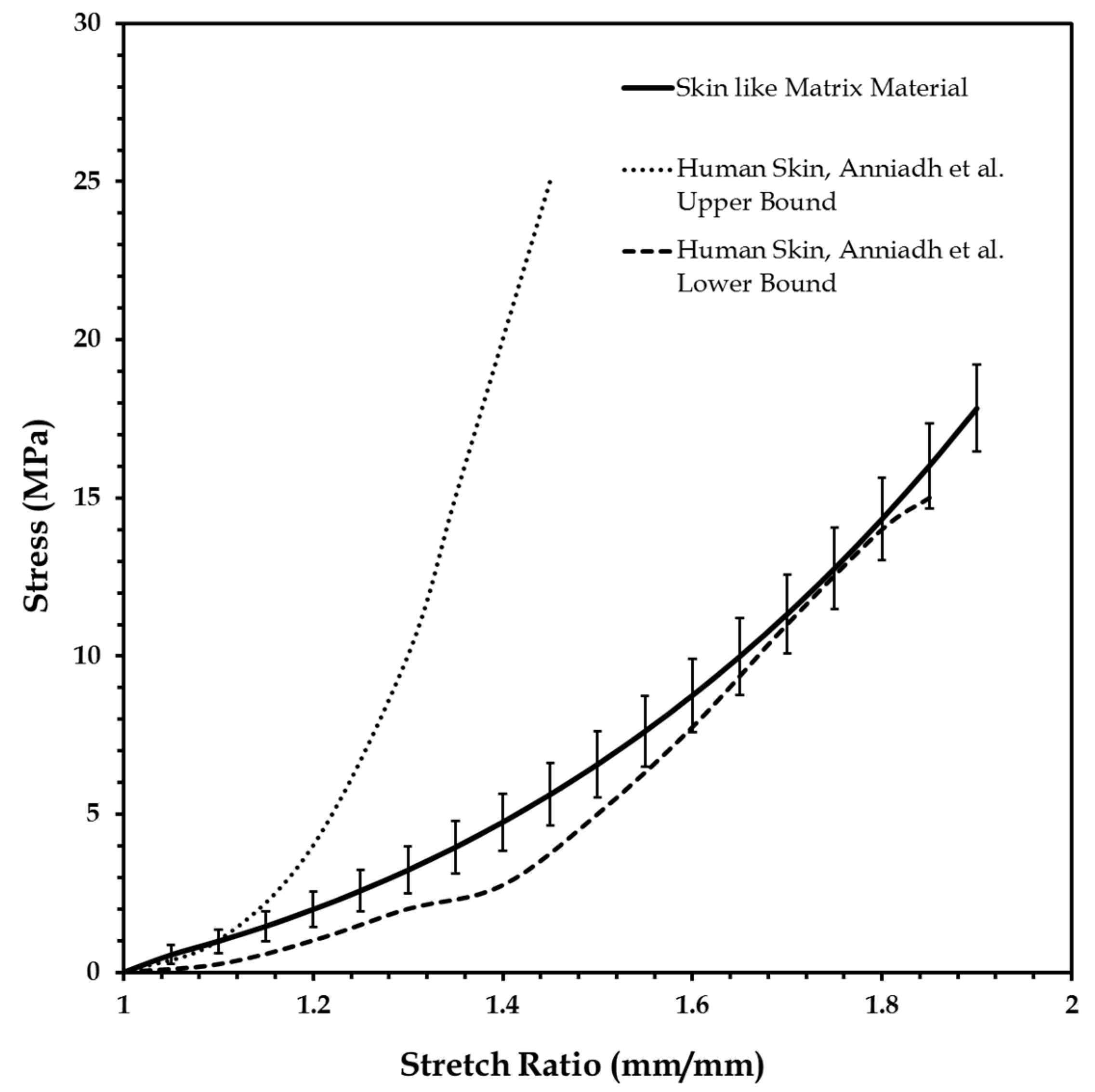
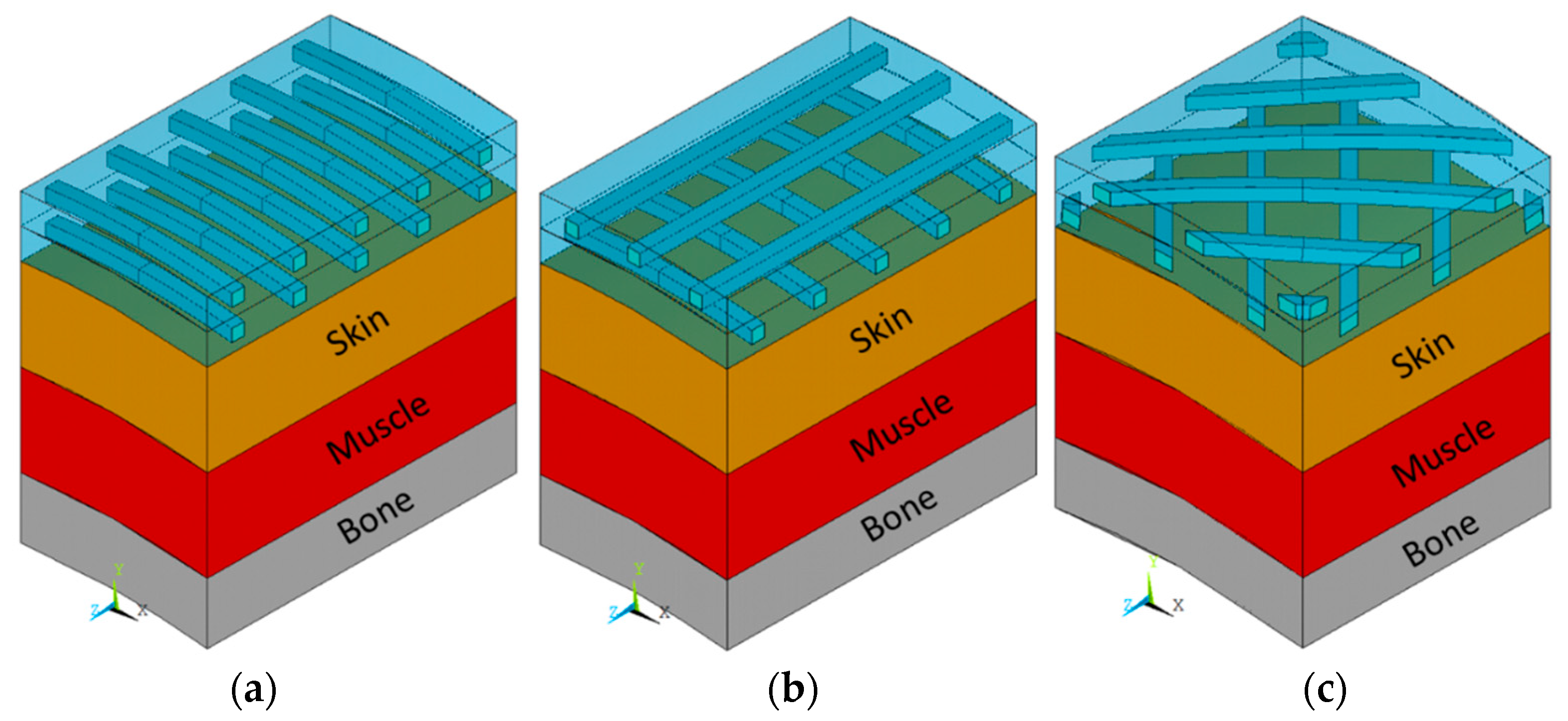



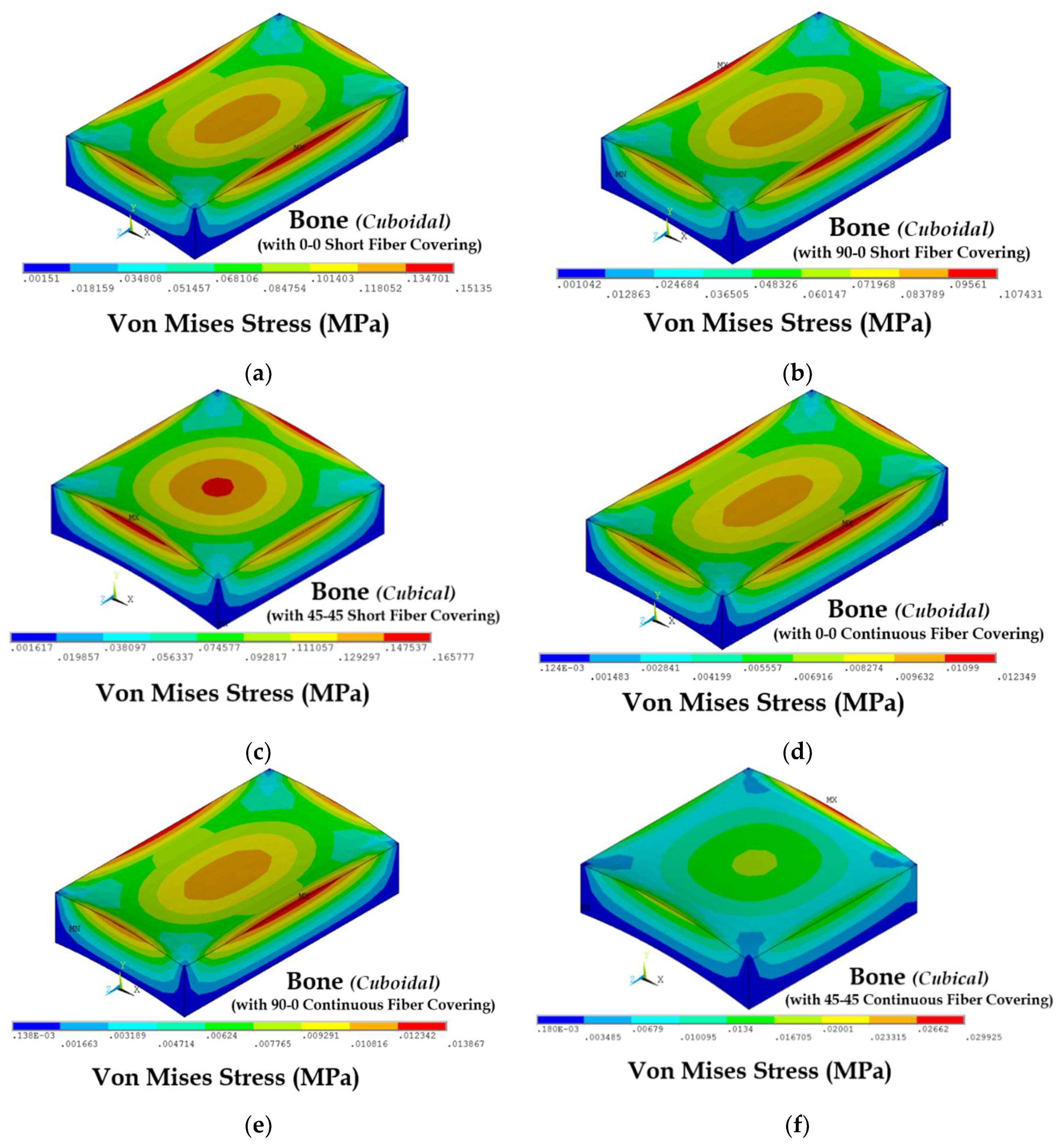

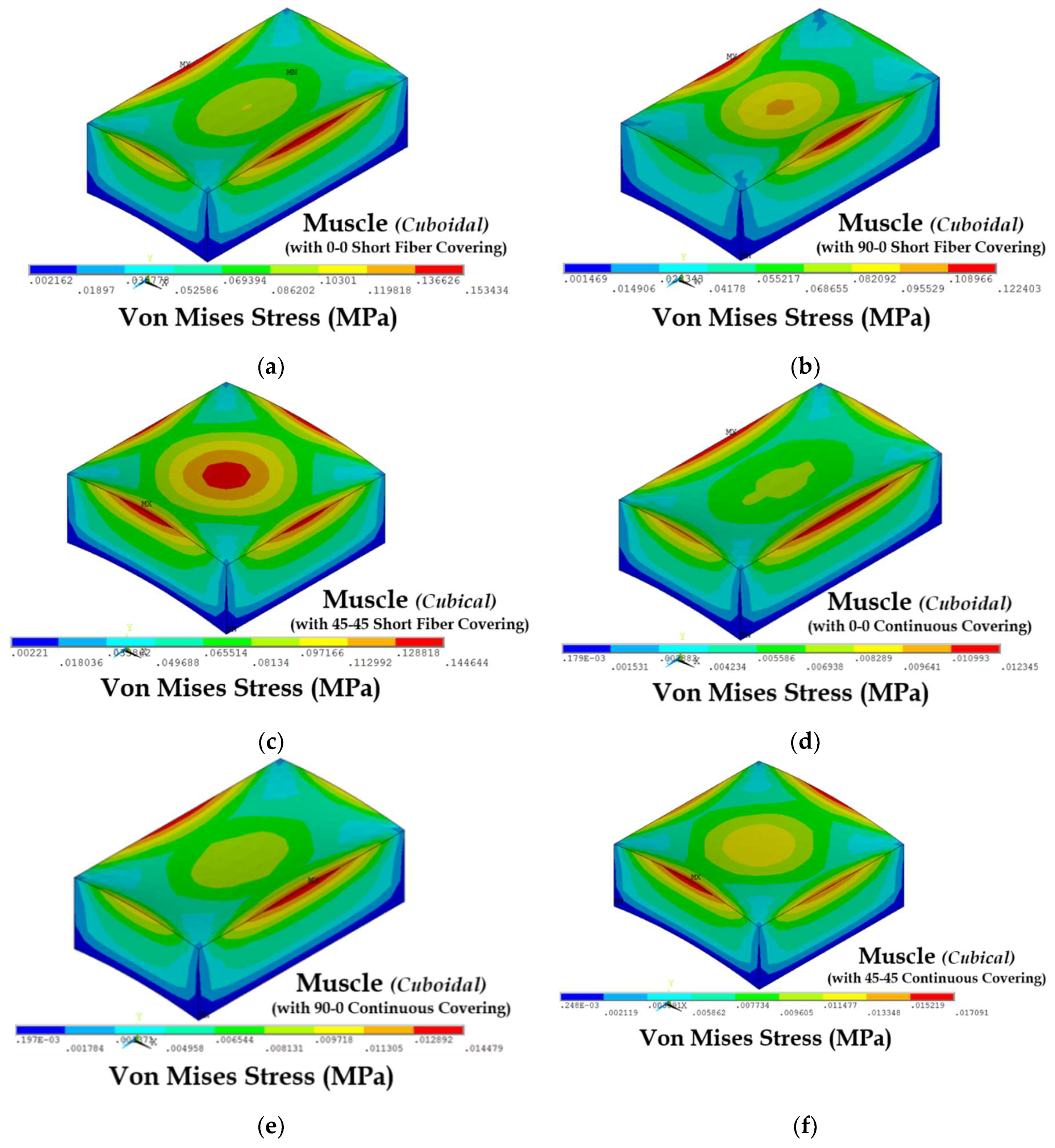


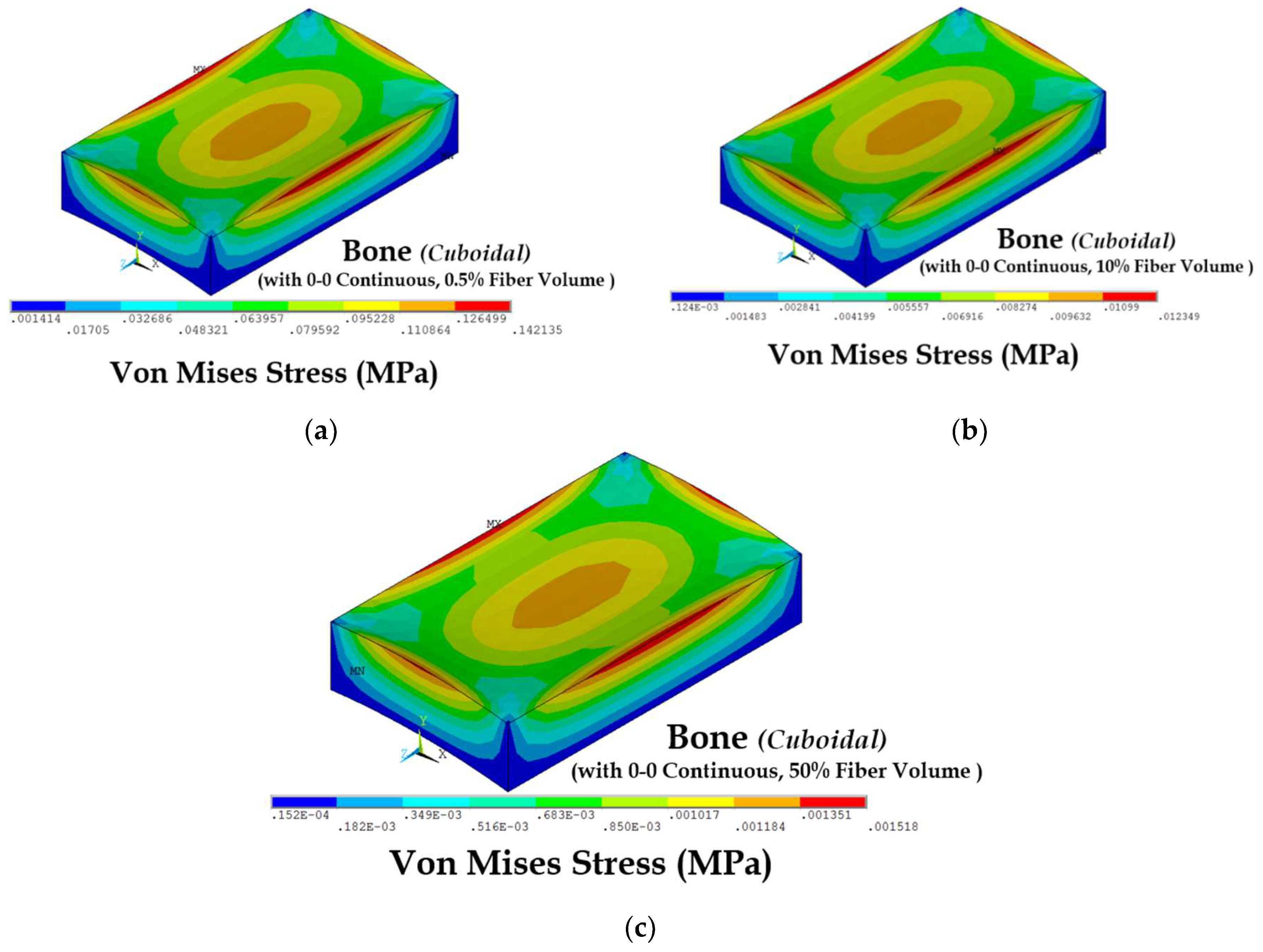
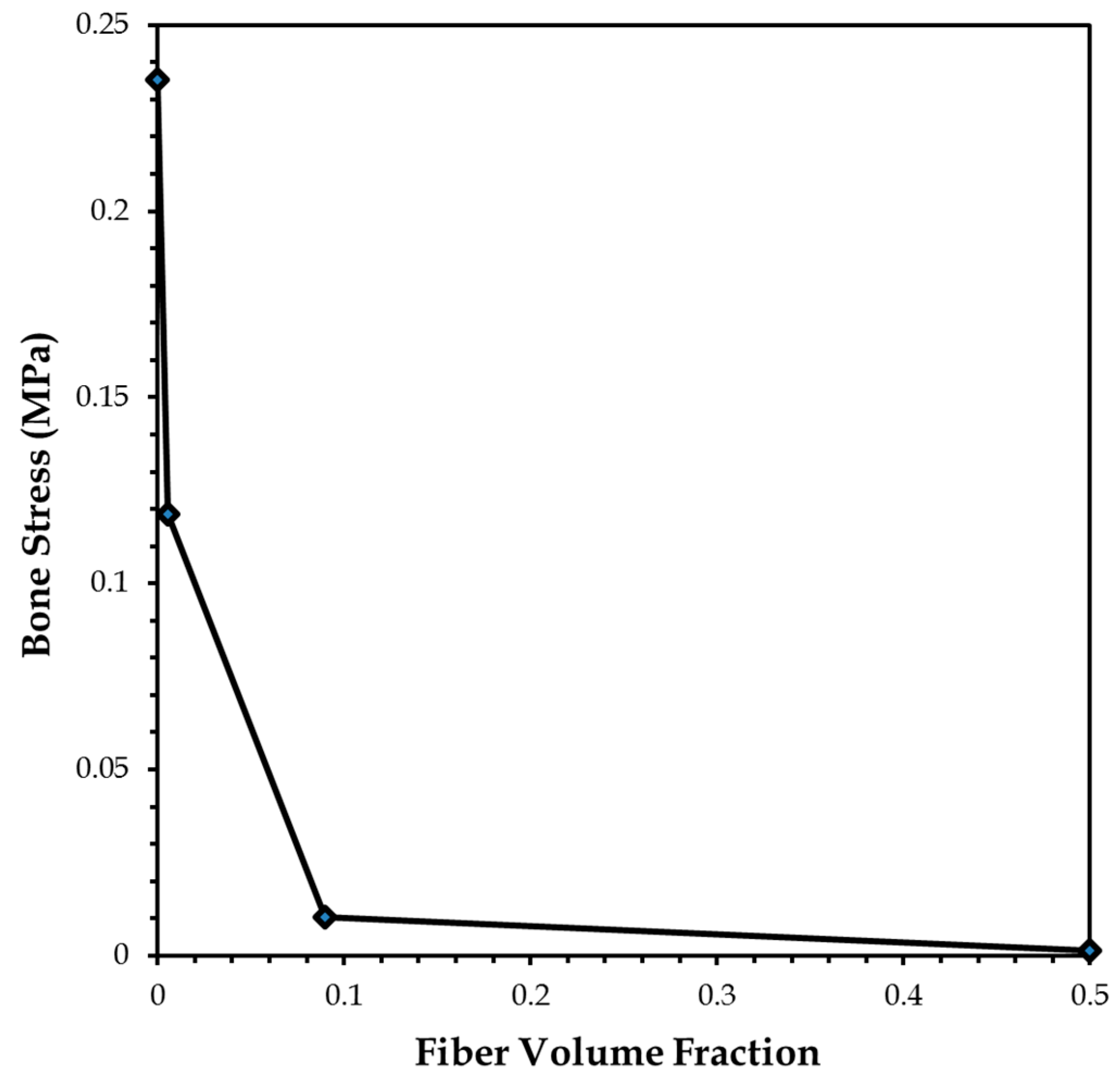
| Non-Linear Material Property for Skin Simulant Used as Matrix Material | ||||
| Yeoh Model Parameters | (MPa) | (MPa) | (MPa) | d1, d2 and d3 |
| 0.946 | 4.948 | 0.015 | 0.225 | |
| Linear Material Properties for Kevlar 129 Fibers | ||||
| Modulus of Elasticity (MPa) | Poisson’s Ratio | |||
| 200,000 | 0.3 | |||
| Material Properties for Body Sections from Literature | ||||
| Linear Elastic Parameters | Modulus of Elasticity (MPa) | Poisson’s Ratio | ||
| Skin | 5 | 0.49 | ||
| Muscle | 100 | 0.46 | ||
| Bone | 15,000 | 0.2 | ||
| Load Step | Time (ms) | Pressure (MPa) |
|---|---|---|
| 1 | 0 to 0.5 | 0 |
| 2 | 0.5 to 0.6 | 0.35 |
| 3 | 0.6 to 1.0 | −0.05 |
| 4 | 1.0 to 3.0 | 0 |
| Composite Covering | 90-0 Short Fiber | 90-0 Continuous | 0-0 Short Fiber | 0-0 Continuous | 45-45 Short Fiber | 45-45 Continuous |
|---|---|---|---|---|---|---|
| Peak Bone Displacement (10−5 mm) | 1.22 | 0.16 | 1.73 | 0.13 | 2.13 | 0.24 |
| Peak Muscle Displacement (10−3 mm) | 3.06 | 0.27 | 3.09 | 0.23 | 4.20 | 0.36 |
© 2018 by the authors. Licensee MDPI, Basel, Switzerland. This article is an open access article distributed under the terms and conditions of the Creative Commons Attribution (CC BY) license (http://creativecommons.org/licenses/by/4.0/).
Share and Cite
Chanda, A.; Graeter, R. Human Skin-Like Composite Materials for Blast Induced Injury Mitigation. J. Compos. Sci. 2018, 2, 44. https://doi.org/10.3390/jcs2030044
Chanda A, Graeter R. Human Skin-Like Composite Materials for Blast Induced Injury Mitigation. Journal of Composites Science. 2018; 2(3):44. https://doi.org/10.3390/jcs2030044
Chicago/Turabian StyleChanda, Arnab, and Rebecca Graeter. 2018. "Human Skin-Like Composite Materials for Blast Induced Injury Mitigation" Journal of Composites Science 2, no. 3: 44. https://doi.org/10.3390/jcs2030044
APA StyleChanda, A., & Graeter, R. (2018). Human Skin-Like Composite Materials for Blast Induced Injury Mitigation. Journal of Composites Science, 2(3), 44. https://doi.org/10.3390/jcs2030044




